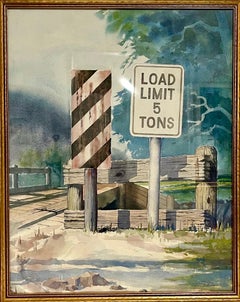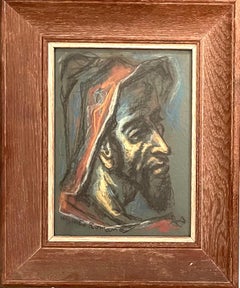Aaron Curry
Watercolor Painting Road Signs, Load Limit, Aaron Bohrod WPA Artist Chicago Art
By Aaron Bohrod
Located in Surfside, FL
, Peggy Bacon, Aaron Bohrod, John Steuart Curry, Luigi Lucioni, and Grant Wood. In the 1950s, Bohrod
Category
Mid-20th Century American Modern Figurative Drawings and Watercolors
Materials
Watercolor
Recent Sales
Original Expressionist Pastel Painting Umberto Romano WPA artist AAA Gallery
By Umberto Romano
Located in Surfside, FL
Thomas Hart Benton, Georgia O'Keeffe, Peggy Bacon, Aaron Bohrod, John Steuart Curry, Luigi Lucioni, and
Category
1940s Expressionist Figurative Paintings
Materials
Paper, Pastel
Get Updated with New Arrivals
Save "Aaron Curry", and we’ll notify you when there are new listings in this category.
Aaron Curry For Sale on 1stDibs
Find the exact aaron curry you’re shopping for in the variety available on 1stDibs. If you’re looking to add a aaron curry to create new energy in an otherwise neutral space in your home, you can find a work on 1stDibs that features elements of brown, gray and more. Artworks like these of any era or style can make for thoughtful decor in any space, but a selection from our variety of those made in paint, board and ink can add an especially memorable touch. If space is limited, you can find a small aaron curry measuring 8.38 high and 8.38 wide, while our inventory also includes works up to 23 across to better suit those in the market for a large aaron curry.
How Much is a Aaron Curry?
The price for an artwork of this kind can differ depending upon size, time period and other attributes — a aaron curry in our inventory may begin at $700 and can go as high as $16,000, while the average can fetch as much as $2,400.
Aaron Bohrod for sale on 1stDibs
Aaron Bohrod's work has not been limited to one style or medium. Initially recognized as a regionalist painter of American scenes, particularly of his native Chicago, Bohrod later devoted himself to detailed still-life paintings rendered in the trompe l'oeil style. He also worked for several years in ceramics and wrote a book on pottery.
Born in 1907, Bohrod began his studies at Chicago's Crane Junior College in 1925, and two years later enrolled in the Art Institute of Chicago. But it was at the Art Students League in New York City, from 1930 to 1932, that he studied under the man believed to be his most significant early influence, John Sloan. Sloan's romantic realism is reflected in the many depictions of Chicago life, which comprised most of Bohrod's early work.
Under Sloan's tutelage, Bohrod came to subscribe to the belief that painters should find the subjects of their art in the immediate world around them. These paintings emphasized architecture unique to north Chicago and featured Chicagoans engaged in such everyday activities as working, playing or going to the theatre. The romantic aspect was conveyed by the use of misty colors, and the realism by attention to detail.
In 1936, Bohrod won the Guggenheim Fellowship award in creative painting. It enabled him to travel the United States, producing similar regionalist paintings on a much broader range of subjects. Nevertheless, most of his early work centered on Chicago and the urban Midwest.
In 1943, Bohrod was commissioned by editors of Life magazine to cover the battlefronts as a war correspondent and artist. Three years later, Bohrod was invited to become the Artist in Residence at the University of Wisconsin, a position that became vacant with the unexpected death of John Steuart Curry. He would remain at the University from 1948 to his retirement in 1973.
Then, quite atypically, fantasy started to appear in his work. Elements of Surrealism, supposedly inspired by his concurrent involvement in ceramics with F. Carlton Ball, began influencing his landscapes. By 1953, Bohrod had completely ceased painting landscapes, turning instead to often symbolic still-life subjects. He abandoned his earlier romantic realism to paint in the luminous trompe l'oeil tradition of William Harnett. Bohrod continued to produce these meticulously crafted fantasies exclusively. While in his position at the University of Wisconsin, Bohrod painted covers for Time magazine and authored two books, A Pottery Sketch-book (1959) and A Decade of Still Life (1966), in which are produced many of his trompe l'oeil paintings.

